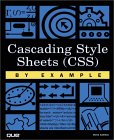Cascading Style Sheets (CSS) By Example
 Title: Cascading Style Sheets (CSS) By Example
Title: Cascading Style Sheets (CSS) By Example
Author: Steve Callihan
Avg. Customer Rating: 5/5
Cascading Style Sheets (CSS) is a technology developed by the World Wide Web Consortium (W3C) to, among other things, give Web Developers more control over the presentation of their pages. It allows you to customise almost every aspect of how the page will appear to a user. From the basics such as font sizes and colours, to the exact pixel location an element should be displayed on a page, you can now gain full control by using CSS. You can even tell your page to display differently depending if it is being viewed on a PC monitor, TV screen, handheld device or printed page!
This review covers a recently released book from Que publishing, Cascading Style Sheets (CSS) By Example, by Steve Callihan. It will attempt to highlight the areas the book stands out from other technical books and provide enough information for you to decide if it should be added to your wish list. Hopefully along the way you will also see how learning CSS, through this book or not, will greatly increase the power you have as a Web Developer.
After receiving this book I was extremely keen to start working through it to gain a better understanding of the concepts behind CSS and what could be achieved with it. While I had worked with CSS before and made use of it to a certain degree when designing WebmastersLibrary.com, I had only ever taught myself enough to get through a particular problem I was working on. I wanted to establish a solid base in the technology so I could start utilising it to its full potential. Having finished reading this book, I can safely say I have just that.
I read this book cover-to-cover, which in my experience is quite rare for a technical book. Steve Callihan was able to keep me interested in every chapter with practical examples, detailed explanations and useful side notes. His continual reference to real world issues such as browser compatibility, standards recommendations and user accessibility helps you gauge the usefulness of particular features in many situations.
The sections of the book that impressed me the most were those that dealt with the underlying concepts of CSS, HTML and related technologies. Many books simply concentrate on the low-level syntax and details of a language without taking that all-important step back to provide an overview to readers. Included in these sections is an excellent explanation on the use of DOCTYPE statements in HTML files. The three HTML 4.01 DOCTYPE flavours are explained, as well as the significance of this often-neglected property. The importance of following standards to ensure a positive browsing experience for all users both now and into the future is also discussed. Just because a browser supports a dodgy display trick in its current version, doesn't mean it will in the next!
One of the main reasons I decided to put off taking a formal approach to learning CSS in the past was the inconsistent and often frustrating implementations in many popular browsers. This book not only proves the current generation of browsers are more than ready for the widespread use of CSS, but provides excellent methods for making sure content is still displayed correctly in older browsers with non-existent/buggy CSS implementations. You have the green light to start learning and using this great technology!
In addition to all these extras, CSS By Example has a comprehensive coverage of CSS level 1 and the basics of CSS level 2. Steve takes a grounds-up approach making this book useful to someone who knows very little or nothing about CSS, while at the same time providing appropriate detail and additional tips to keep even an experienced developer interested. To aid his teaching, Steve provides usable examples in each chapter (which are available from his Website, as well as within the book) to give a practical and visual reference of a particular set of features. Screen shots in today's most popular browsers are also provided.
CSS By Example also covers some of the concepts in CSS many people find confusing or more difficult to grasp. These include grouping, classes, ids, inheritance and cascading. Previous books and materials I have read that deal with these issues tended to either dodge the topic or totally confuse the concept all together. I can now safely say that I do know what the "Cascading" in Cascading Style Sheets means!
In conclusion, if you are looking for a book to learn CSS from scratch, or simply want to gain a better grounding in the technology, I have no hesitations recommending CSS By Example. You will find it thorough, authoritative and easy to read, giving you the necessary knowledge to start making attractive, standards compliant websites in much less time than you used to! CSS By Example is also one of those books that will never find a permanent place on your bookshelf. I have found myself continually referring back to it ever since completing the book! Steve Callihan has done a great job with this one, and you should seriously consider checking it out.
